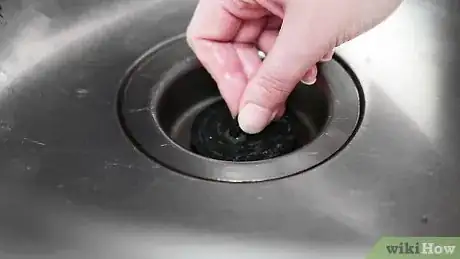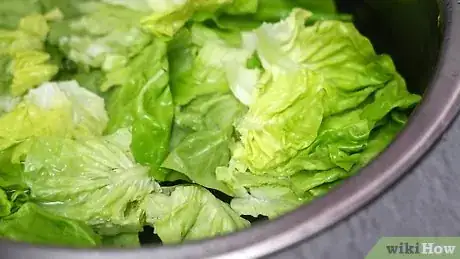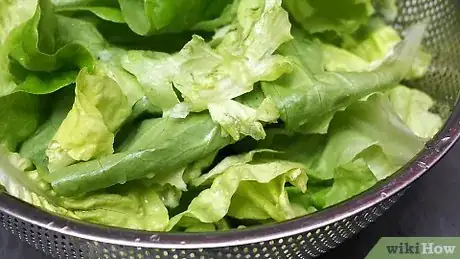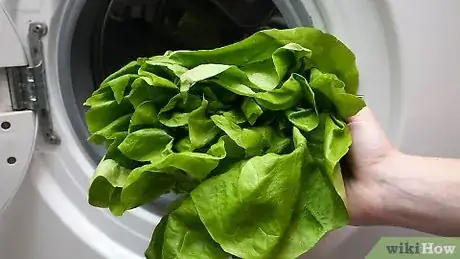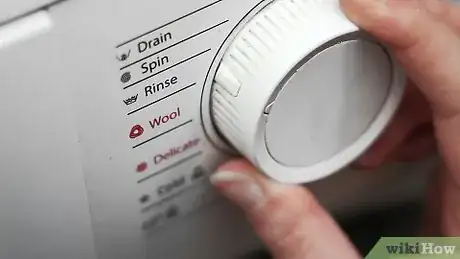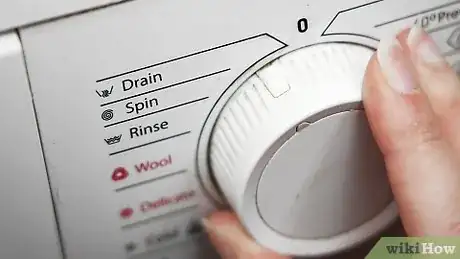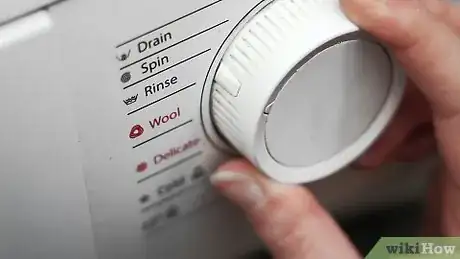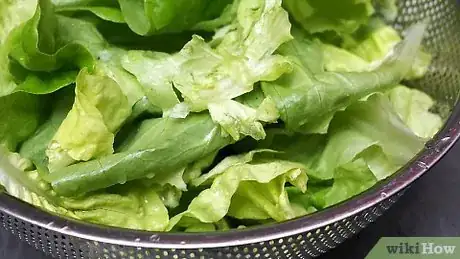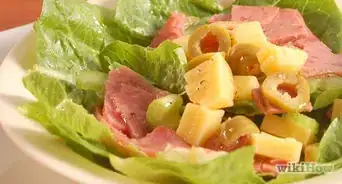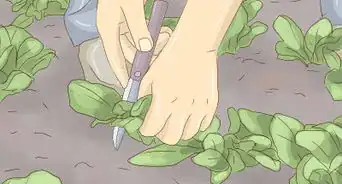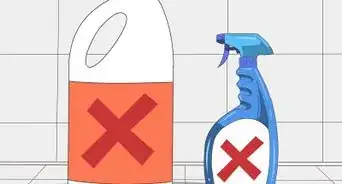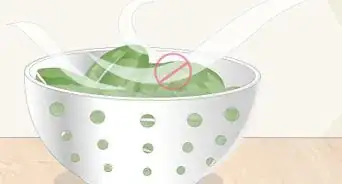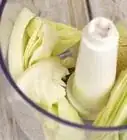wikiHow is a “wiki,” similar to Wikipedia, which means that many of our articles are co-written by multiple authors. To create this article, 37 people, some anonymous, worked to edit and improve it over time.
The wikiHow Video Team also followed the article's instructions and verified that they work.
This article has been viewed 240,494 times.
Learn more...
"Greens" is just a nice, quick way of saying green, leafy vegetables. These are veggies like lettuce, cabbage, and spinach. Unfortunately, these leaves are great for catching pesticides and other chemicals that you may not want in your body. And even if they're organic, there can be dirt and who knows what else from those that handled it. So, you've got to clean them. And the easiest way to clean greens is with a lot of water in the sink.
Steps
By Hand
-
1Clean the sink thoroughly inside and around the edges, making sure not to leave any soap residue behind. It doesn't have to be sterile, just washed down so there aren't any food remnants or other contaminants. The larger the sink, the better.[1]
-
2Stop up the sink, but don't fill it with water just yet.Advertisement
-
3Know that the easiest way to core and separate a head of lettuce is to firmly (but not squeezing) hold the head of greens in your hands with the stem side down and strike the cut end of the stem against a counter top.[2] This usually cores the head in one or two blows. Then you may pull greens apart (so that nothing remains between leaves that are stuck together) and put them in the sink. For smaller baby greens the stem can usually be pinched away with a thumb and forefinger. To remove tough stems from greens, fold the greens in half along the stem line with one hand clasping close to the stem. With the other hand rip away the stem from the base toward the tip of the leaf. Discard the heart (unless you plan to use the heart for a dish) and any tough stems.
-
4Fill the sink with cool water.
-
5Agitate the greens around gently with your hands to circulate the water through them thoroughly. Each leaf should be submerged and moved around.[3]
-
6Let the leaves sit for a couple minutes, to allow the dirt to settle on the bottom of the sink.
-
7Lift out the leaves one or two at a time, tearing them into the size you want, or leaving them whole for use later. If you pull a leaf out of the water and it still seems dirty, swish it around in the water gently or, if you have a double sink, run it under the tap in the other sink. Try not to stir the water (and dirt) up too much.[4]
-
8Put the leaves in a colander to drain. If you place the colander in the sink, make sure you have drained the sink fully and rinsed away any remnants. To remove excess water from greens, place the greens in the center of a large piece of cotton muslin (36' x 36'). Gather up the four corners and four edges of the muslin and grasp firmly. Go outside (or in a shower stall) and swing your arm around in a big circle. The water will spin away from this centrifuge action. Then while you prepare the rest of your meal you can open up the muslin and place the greens on a surface somewhere cool and dry, so the greens dry off even further. You can also use a salad spinner, but muslin is much easier to store and less expensive. Dry greens make the best salads -- the salad dressing is not diluted by rinse water, and the leaves are less prone to rot when the salad is stored.[5]
With a Washing Machine
-
1Consider using a washing machine if you have a large amount of sandy greens. This method isn't practical for most situations. But if you have harvested a lot of greens from your garden that have a lot of dirt or sand on them, this can be a good way to go.[6]
-
2Rinse out the washing machine thoroughly so that there's no residue remaining.
-
3Set the delicate cycle, with cold water.
-
4Put the greens in the washing machine and let them swish around for up to 5 minutes, but don't let them spin (see Tips).
-
5Drain the water.
-
6Do a single rinse in cold water.
-
7Pull out the greens and drain them in a colander. Don't put them in a dryer!
Community Q&A
-
QuestionWhat happens if I don't add enough of water to the sink?
 Community AnswerThe reason you add a lot of water to the sink is to separate the greens from the dirt. If there is enough water in the sink, the greens will float, and the dirt will sink to the bottom (which ideally should be several inches below the bottom of the greens). If you do not have enough water in the sink, the greens will be in contact with the bottom of the sink where all the dirt is. This will leave dirt on the leaves, making the greens gritty when you eat them.
Community AnswerThe reason you add a lot of water to the sink is to separate the greens from the dirt. If there is enough water in the sink, the greens will float, and the dirt will sink to the bottom (which ideally should be several inches below the bottom of the greens). If you do not have enough water in the sink, the greens will be in contact with the bottom of the sink where all the dirt is. This will leave dirt on the leaves, making the greens gritty when you eat them. -
QuestionHow do I clean greens so that harmful bacteria is washed away?
 Community AnswerWash in a bowl with a solution of 1/4 cup vinegar and 6 cups cold water. Then rinse thoroughly under a running cold water tap. Place on paper towels and roll up to take most of the water off, then store in new paper towels in plastic bags.
Community AnswerWash in a bowl with a solution of 1/4 cup vinegar and 6 cups cold water. Then rinse thoroughly under a running cold water tap. Place on paper towels and roll up to take most of the water off, then store in new paper towels in plastic bags. -
QuestionCan I use a hair dryer as well to dry the wet greens?
 KateyKateCommunity AnswerA hair dryer would not be a good option to dry greens - any sort of heat at all on the greens and they will likely wilt. You can use a salad spinner to remove excess water.
KateyKateCommunity AnswerA hair dryer would not be a good option to dry greens - any sort of heat at all on the greens and they will likely wilt. You can use a salad spinner to remove excess water.
Warnings
- Using a washing machine to clean greens is more appropriate for large amounts of greens (i.e. cleaning in preparation to sell). Otherwise, it's a waste of energy and water.⧼thumbs_response⧽
- With turnip, mustard, collard and other sand grown greens-Remember you'll be boiling the greens later so a sanitized washer isn't necessary. If you have small children and "accidents" are common you should do an empty load with a touch of bleach before cleaning your greens. Don't wash the greens in bleach! Just do an empty load (water only) with a touch of bleach to kill any bacteria.⧼thumbs_response⧽
- Some greens are sold pre-washed. You should still rinse these in a sink of cold water as debris is still found in the "triple washed" bags.⧼thumbs_response⧽
- If you're handling lettuce greens, be gentle unless you don't mind limp, wrinkly lettuce.⧼thumbs_response⧽
- If you do use a washing machine, don't use a public one, and remember that dirty clothes with all their bacteria are washed there, too!⧼thumbs_response⧽
- to avoid soaps and bacteria from the washing machine, you can run your machine through the rinse cycle before starting the washing process or do an empty load with hot water.⧼thumbs_response⧽
References
- ↑ https://www.thekitchn.com/how-to-clean-your-kitchen-sink-249020
- ↑ https://www.insider.com/core-lettuce-hack-2014-4
- ↑ https://www.webmd.com/diet/features/lettuce-learn-wash-produce-properly
- ↑ https://www.youtube.com/watch?v=9JEwid6UoOs
- ↑ https://www.eatright.org/homefoodsafety/four-steps/wash/washing-leafy-greens
- ↑ https://www.bonappetit.com/test-kitchen/cooking-tips/article/right-way-wash-fresh-greens
About This Article
To clean greens, start by pulling the leafy greens off their tough stem and placing them in your sink. Then, fill the sink with cold water and move the greens around with your hands to rinse them off. When you're finished, leave the greens to soak in the water for a few minutes. Finally, transfer them to a colander to drain. To learn how to clean greens in a washing machine, scroll down!

